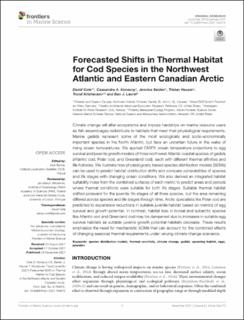| dc.contributor.author | Cote, David | |
| dc.contributor.author | Konecny, Cassandra A. | |
| dc.contributor.author | Seiden, Jennica | |
| dc.contributor.author | Hauser, Tristan | |
| dc.contributor.author | Kristiansen, Trond | |
| dc.contributor.author | Laurel, Ben J. | |
| dc.date.accessioned | 2022-01-18T13:45:02Z | |
| dc.date.available | 2022-01-18T13:45:02Z | |
| dc.date.created | 2021-12-29T00:16:29Z | |
| dc.date.issued | 2021 | |
| dc.identifier.citation | Frontiers in Marine Science. 2021, 8, 764072. | en_US |
| dc.identifier.issn | 2296-7745 | |
| dc.identifier.uri | https://hdl.handle.net/11250/2837998 | |
| dc.description.abstract | Climate change will alter ecosystems and impose hardships on marine resource users as fish assemblages redistribute to habitats that meet their physiological requirements. Marine gadids represent some of the most ecologically and socio-economically important species in the North Atlantic, but face an uncertain future in the wake of rising ocean temperatures. We applied CMIP5 ocean temperature projections to egg survival and juvenile growth models of three northwest Atlantic coastal species of gadids (Atlantic cod, Polar cod, and Greenland cod), each with different thermal affinities and life histories. We illustrate how physiologically based species distribution models (SDMs) can be used to predict habitat distribution shifts and compare vulnerabilities of species and life stages with changing ocean conditions. We also derived an integrated habitat suitability index from the combined surfaces of each metric to predict areas and periods where thermal conditions were suitable for both life stages. Suitable thermal habitat shifted poleward for the juvenile life stages of all three species, but the area remaining differed across species and life stages through time. Arctic specialists like Polar cod are predicted to experience reductions in suitable juvenile habitat based on metrics of egg survival and growth potential. In contrast, habitat loss in boreal and subarctic species like Atlantic cod and Greenland cod may be dampened due to increases in suitable egg survival habitats as suitable juvenile growth potential habitats decrease. These results emphasize the need for mechanistic SDMs that can account for the combined effects of changing seasonal thermal requirements under varying climate change scenarios. | en_US |
| dc.language.iso | eng | en_US |
| dc.publisher | Frontiers | en_US |
| dc.rights | Navngivelse 4.0 Internasjonal | * |
| dc.rights.uri | http://creativecommons.org/licenses/by/4.0/deed.no | * |
| dc.title | Forecasted Shifts in Thermal Habitat for Cod Species in the Northwest Atlantic and Eastern Canadian Arctic | en_US |
| dc.type | Peer reviewed | en_US |
| dc.type | Journal article | en_US |
| dc.description.version | publishedVersion | en_US |
| dc.rights.holder | Copyright © 2021 Cote, Konecny, Seiden, Hauser, Kristiansen and Laurel | en_US |
| dc.source.pagenumber | 15 | en_US |
| dc.source.volume | 8 | en_US |
| dc.source.journal | Frontiers in Marine Science | en_US |
| dc.identifier.doi | 10.3389/fmars.2021.764072 | |
| dc.identifier.cristin | 1972583 | |
| dc.source.articlenumber | 764072 | en_US |
| cristin.ispublished | true | |
| cristin.fulltext | original | |
| cristin.qualitycode | 1 | |

